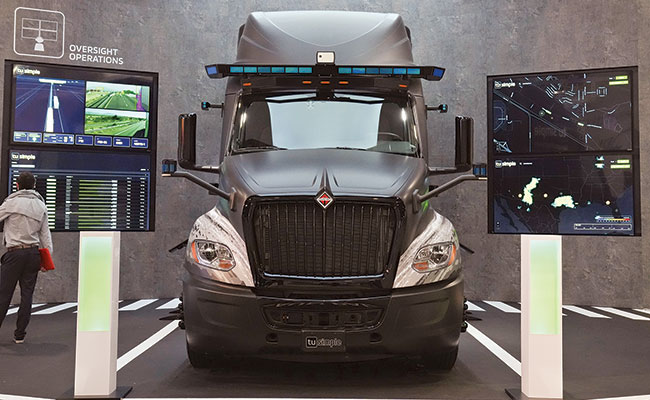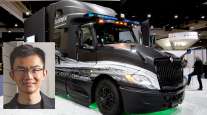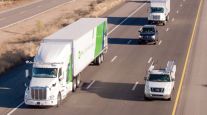Staff Reporter
5G Transition Opens New Opportunities for Autonomous Trucks

[Stay on top of transportation news: Get TTNews in your inbox.]
The transition to a 5G wireless network is likely to open up new opportunities in terms of autonomous trucking technology.
“The most critical aspect of connectivity for autonomous vehicles is high levels of reliable connectivity,” said Chris Gutierrez, director of research and development of autonomous systems at Navistar. “The transition to 5G will enable new opportunities to improved coverage and reliability of the existing 4G networks.
"While autonomous vehicles may not require 5G technology in all cases to complete their tasks, the build-out of the new network will provide the opportunities to raise the bar and lessen the burden on the autonomous vehicles.”

Gutierrez
Navistar is among the truck manufacturers that have focused on developing driverless technologies. That includes partnering with autonomous driving technology company TuSimple to develop a commercial-ready Level 4 fully autonomous driving solution for longhaul heavy-duty trucks. At Level 4, human interaction is not required during operation.
“One of the biggest benefits is that 5G promises lower latency — around 5 milliseconds versus 4G’s range at 60-90ms,” a TuSimple spokesperson said. “With this improved performance, a truck going down the freeway with a reliable connection is able to receive information much quicker. This is one of the more helpful features when compared to older technologies. For example, with lower latency, autonomous remote operation centers in the cloud can get traffic condition change information to the trucks quicker.”
The spokesperson added that another benefit of 5G capability is that upload speeds can be about 30% faster. The performance improvement will offer better visibility for remote operators keeping an eye on the truck when they stream camera and lidar data to the cloud.
“All and all, 5G will become more useful especially when the autonomous fleets start to scale and are more widely available on the road,” the spokesperson said. “Getting ubiquitous wireless coverage remains the most important component regardless of speeds when it comes to connectivity.”

A Navistar International truck equipped with TuSimple autonomous technology on display at 2022 CES in Las Vegas. (Joe Buglewicz/Associated Press)
Driverless technology companies are unlikely to rely on mobile networks for primary functions because the autonomous truck systems need to be able to operate safely and independently. Sensors and cameras are more reliable for fast and uninterrupted readings of conditions, but mobile networks may be useful for secondary functions such as sourcing information on traffic and weather.
“Although Plus is developing our autonomous driving technology and products independent of 5G or V2X being available, faster V2X implementation made possible by 5G technology would lead to safer mobility and less traffic congestion,” Plus Chief Operating Officer Shawn Kerrigan said. “This creates a safer road environment for fully autonomous trucks to operate in, in addition to the safety gains that self-driving trucks already bring about on their own.”

Kerrigan
Daimler Truck AG and Torc Robotics entered into their fourth year of partnership Oct. 6. Their focus has been on industry collaboration and commercializing of Level 4 autonomous trucks in the U.S. for longhaul applications. Daimler Truck gained a majority share in Torc in 2019.
“The sensors installed in the vehicle [camera, lidar, radar] plus a highly accurate map are responsible for ensuring that the automated vehicle can safely navigate and detect objects,” Daimler Truck and Torc said in a statement. “5G is not absolutely necessary for automated driving. However, in vehicle-to-infrastructure communication, 5G is a promising new technology that we are investigating.”

TT's Eugene Mulero joins host Mike Freeze to discuss the midterm elections, and what the fight for control of Congress will mean for trucking. Tune in above or by going to RoadSigns.ttnews.com.
The statement also noted that the technology could enable the exchange of messages between vehicles and road infrastructure or other systems. This makes it possible for the system to understand when there is a potential for dangerous situations such as slippery ice on bridges, or traffic information such as sudden stopped traffic behind a hilltop earlier.
“Vehicle-to-X communication thus represents an additional, potential sensor for future development,” the statement continued. “While our current, short-term goals for Level 4 technology do not include 5G integration, we see the opportunity in vehicles that can communicate regardless of their position in order to be able to use it across the board, to provide own relevant information and to get traffic information and warnings, road information about construction sites or weather conditions, map updates, etc.”
Want more news? Listen to today's daily briefing above or go here for more info
AT&T on Feb. 22 became the first major network to make the transition. This represented a major step in cellular service providers shutting down their 3G networks to free wireless spectrum for existing 4G LTE and the still-expanding 5G networks.
“Our autonomous vehicles don’t rely on a constant wireless connection for the vehicle to operate safely and don’t use V2V, 5G or teleoperation/remote driving,” a Waymo spokesperson said. “We may use a cell connection to share supplemental information with the vehicle’s autonomous driving system about conditions on the road, but all the driving decisions are made by our tech — the Waymo Driver — itself, relying primarily on the on-board sensors [lasers, radar, cameras, etc.]. Our approach is based on our belief that an autonomous driving system, which is rigorously tested and has backup systems and redundancies to handle the unexpected, is the safest model.”




